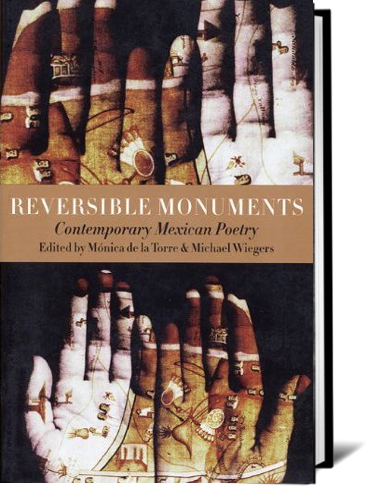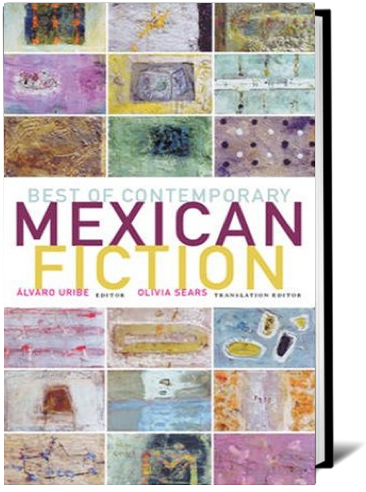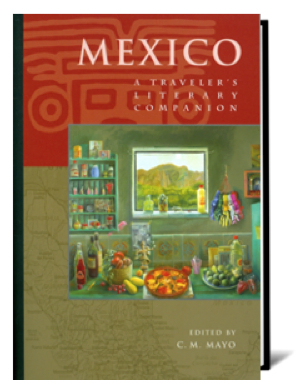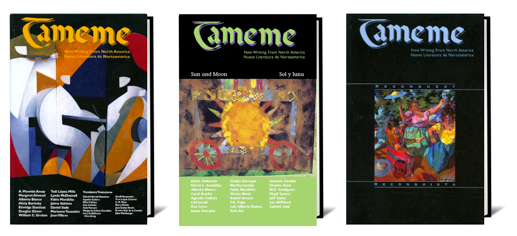 Muchísimas
gracias, Mark Weiss,
and thank you also to my fellow panelists [Wendy Burk, Catherine
Hammond], it is an honor to sit on this dias with you. Thank
you all for coming. It is especially apt to be talking about
translating Mexican writing here, a jog from the Mexican border,
in Tucson—or Tuk-son as the Mexicans pronounce it.
Muchísimas
gracias, Mark Weiss,
and thank you also to my fellow panelists [Wendy Burk, Catherine
Hammond], it is an honor to sit on this dias with you. Thank
you all for coming. It is especially apt to be talking about
translating Mexican writing here, a jog from the Mexican border,
in Tucson—or Tuk-son as the Mexicans pronounce it.
I grew up in Northern California
and was educated in various places but mainly the University
of Chicago. As far as Mexico went, until I was in my mid-twenties,
I had absorbed, to use historian John Tutino's term, the “enduring
presumptions.” Translation: I had zero interest in Mexico.
You know that old saying, if
you want to make God laugh, tell her your plans?
What brought me to translating
Mexican poetry and literary prose was that I married a Mexican—my
fellow graduate student at University of Chicago— and we
moved to his hometown, Mexico City, in 1986. I am happy to say
that we are about to celebrate our 30th anniversary.
For me, as a writer, and as a
translator, these decades, mainly spent in Mexico City, have
been a grand adventure in learning and exploring the cultures,
histories, and geography of Mexico and of course, learning Spanish.
I cannot claim that I speak and write Spanish like a native—I
started learning Spanish when I was 24 years old.
But after three decades in Mexico... well, after three decades
of living in any country, if you haven’t learned the language,
at least to level of conversation and daily business... I was
about to say something unkind.
My husband has his own and very
distinguished career as an economist but I call him my Translation
Assistant. Although I would say I am fluent in Mexican Spanish,
as all of you well know, literary translation can be fluky-tricky.
Many a time he has rescued me from what would have been toe-curling
embarrassment. May we all have our translation assistants.
 It
was back in the early 1990s, when I started writing my own poetry
and short fiction, that I had two epiphanies. First epiphany:
I could do this! I mean, I knew some Spanish and at the same
time, I could write literary fiction and poetry myself. I was
beginning to get my own stories
and poems published in
well-regarded literary journals, such as the Paris Review,
The Quarterly, Southwest Review. That gave me a shot of confidence.
To this day, I really believe that the best literary translators
are not necessarily the most fluent, the most perfectly bilingual,
but rather, those who can render the work into the same literary
level in the target language.
It
was back in the early 1990s, when I started writing my own poetry
and short fiction, that I had two epiphanies. First epiphany:
I could do this! I mean, I knew some Spanish and at the same
time, I could write literary fiction and poetry myself. I was
beginning to get my own stories
and poems published in
well-regarded literary journals, such as the Paris Review,
The Quarterly, Southwest Review. That gave me a shot of confidence.
To this day, I really believe that the best literary translators
are not necessarily the most fluent, the most perfectly bilingual,
but rather, those who can render the work into the same literary
level in the target language.
And the second epiphany was that
appallingly little Mexican work was being translated into English.There
were some books, mainly from university presses, the occasional
anthology, and here and there, a poem in a literary magazine,
but I was in Mexico City, in Coyoacán, I could see what
was going on, the rich, flourishing literary culture. It was
obvious to me that this was not registering in the literary communities
north of the border, not the way it should.
 For me, getting to know Mexican poets
and writers was not difficult. Back in those days of yore, before
the Internet ... well, one important poet, Manuel Ulacia, was
my neighbor. We would often see each other out walking our dogs.
For me, getting to know Mexican poets
and writers was not difficult. Back in those days of yore, before
the Internet ... well, one important poet, Manuel Ulacia, was
my neighbor. We would often see each other out walking our dogs.
But let me back up for a broader
perspective.
Mexico shares a 2,000 mile border
with the United States, spanning the southern borders of California,
Arizona, New Mexico, and the greater part of Texas. And Mexico
has some of the richest literary traditions in the world.
It starts with the codexes of
the Maya and the Aztecs, and others—and as a quick side
note, there is a book forthcoming in 2016 from University of
Texas Press by archaeologist Dr. Carolyn Boyd, in which she argues
that the White Shaman rock site near the U.S.Mexico border in
the Lower Pecos Canyonlands, which is thousands of years old,
is actually a codex— and basing some of her arguments on
the work of Mexican anthropologists, Dr. Boyd has decoded it.
It tells the story of creation. And so we can think about “White
Shaman” as the first known book in North America. North
America, of course, includes Mexico. And the Texan side of the
Lower Pecos Canyonlands was once part of Mexico.
And speaking of books, you may
recall the hullabaloo about the 14.2 million dollar sale of a
copy of the first English language book printed in the New World,
The Whole Booke of Psalmes of 1640. Well, that was more
than one hundred years after the first Spanish language book
was printed in Mexico City. That was Breve y más compendiosa
doctrina Christiana en lengua Mexicana y Castellana, printed
in 1539. And there may have been an even earlier book printed
in 1537, Escala Espiritual par llegar al cielo, but no
known copies survive.
In the prologue to my anthology of 24 Mexican writers, Mexico: A Traveler’s
Literary Companion, I write, “Mexican literature—a
vast banquet—is one of the greatest achievements if the
Americas. And yet we who read in English have gone hungry, for
so astonishingly little of it has been published.”
Mexico: A Literary Traveler’s
Companion was published
in 2006 and although I know many of you and other members of
ALTA, and other translators, have since then published many Mexican
works in translation, and anthologies, this scarcity, this appalling
scarcity of translations of works from our neighboring country,
continues.
 I could go on with names, book titles,
and numbers from the publishing industry, but it would be too
sad. To give you the simplest and most concrete sense of how
sad this situation is, when the sales team asked for blurbs for
Mexico: A Traveler’s Literary Companion, I really
had a problem. Of course there are many anthologies of English
language writing about Mexico. But Mexicans writing about Mexico?
I would have to ask a Mexican for a blurb. But what Mexican?
I could go on with names, book titles,
and numbers from the publishing industry, but it would be too
sad. To give you the simplest and most concrete sense of how
sad this situation is, when the sales team asked for blurbs for
Mexico: A Traveler’s Literary Companion, I really
had a problem. Of course there are many anthologies of English
language writing about Mexico. But Mexicans writing about Mexico?
I would have to ask a Mexican for a blurb. But what Mexican?
Octavio Paz? Yes, he won the
Nobel Prize. But he was dead.
Carlos Fuentes? He was in the
anthology himself, so asking him for a blurb would have been
awkward. Anyway, he wasn't answering his email.
Sales reps and bookstore buyers,
for the most part, did not recognize the name of any Mexican
writer.
Salma Hayek? I suggested.
The sales rep answered, “WOW!
That would be GREAT!”
(No offense intended to Ms Hayek,
an accomplished Mexican actress and producer. But methinks a
blurb from her, had I been able to wrangle one, would have carried
about as much clout as that of, say— to scramble it into
Texanese, porquois pas— a rodeo barrel racing champion opining
on the national polo team.)
We ended up using a blurb Isabelle
Allende had provided for the Traveler’s Literary Companion
series itself—a series from Whereabouts
Press that includes many countries, among them, Chile, Costa
Rica, Cuba, and as far afield as Australia and Viet Nam.
And I managed to wrangle a blurb
from a translator who is a queen among us—I know many of
you will recognize her name—Margaret
Sayers Peden. She wrote:
“This delicious
volume has lovingly gathered a banquet of pieces that reveal
Mexico in all its infinite variety, its spendid geography, its
luminous peoples. What a treat!”
Bless her heart.
Apart from the anthology and
various contributions to other anthologies and literary magazines,
for a few years I founded and edited Tameme,
a bilingual literary journal of new writing from Canada, the
US and Mexico. That was a project I did with my dad, Roger
Mansell, who had 25 years of experience in the graphic arts
and printing business in San Francisco. So if I do say so myself,
the three issues of Tameme and two chapbooks were quite
beautiful and they should be collector’s items. Unfortunately
my dad passed away, and with my own books to write, Tameme
was more than I could handle.

But I have continued to translate.
A few of the writers and poets I have translated in recent, post-Tameme
years include Agustín
Cadena for BorderSenses and Chatahoochie Review
and various anthologies, most recently, Sarah Cortez’s Goodbye Mexico: Poems of Remembrance.
I also recently published a story by Ignacio Solares in Lampeter
Review, and am working on a second story by Solares and another
by Araceli Ardón.
A story by Rose Mary Salum was published
in a very fine a new literary magazine edited by Dini Karasik
called Origins.
And I am also working on translating Rose Mary Salum's forthcoming
book, El agua que mece el silencio,
as The Water That Rocks the Silence.
Apart from Tameme, the
largest translation project I have undertaken to date is a strange
one, and I bring it up because I know that for many of you the
question of rights is a concern. A book that is out of copyright,
you can grab that, you can translate that. Go to it!
Last year for ALTA, when the
topic was “Politics and Translation,” for two different
panels I talked about that book, or rather my book about that
book. The title of my book is Metaphysical
Odyssey into the Mexican Revolution: Francisco I. Madero and
His Secret Book, Spiritist Manual. And it does include
the complete first translation of Spiritist Manual.
Francisco Madero was the leader
of Mexico’s 1910 Revolution and President of Mexico from
1911 to 1913, when he was overthrown in a coup d’etat and
murdered. Madero was a Spiritist medium, that is, he believed
he could communicate with the dead—and so can you! His secret
book, Spiritist Manual, written in 1910—the year
he launched the Revolution—and published under a pseudonym
when was president elect in 1911, is... all about that. And I
translated it because nobody else had.
As I said in my
panel talk last year,
I cannot not
deny other motives and the millions of other participants in
that Revolution of 1910. But its spark, and the way it played
out, and, I believe, Madero's murder, become a radically different
story once we take into account his Spiritism.
My aim with my
book and my translation of Madero's book is to deepen our understanding
of Madero, both as an individual and as a political figure; and
at the same time, deepen our understanding of the rich esoteric
matrix from which his ideas sprang, in other words, not to promote
his ideas nor disparage them, but explain them and give them
context.
It is also then
my aim to deepen our understanding of the 1910 Revolution and
therefore of Mexico itself, and because the histories are intertwined,
therefore also deepen our understanding of North America, Latin
America, the Pacific Rim, and more— for as long as a book
exists, should someone happen to read it, it can catalyze change
in understanding (and other changes) that ripple out, endlessly.
Such is the wonder,
the magical embryonic power of a book, any book, whether original
or in translation: that, even as it rests on a dusty shelf for
a hundred years, or for that matter, an unvisited digital "shelf,"
if it can be found, if it can be read, it holds such potential.
To conclude: I mainly translate
contemporary Mexican short fiction and poetry. It is a labor
of love and, as an English language writer who lives in Mexico
City, a way for me to engage with Mexico and with my Mexican
colleagues. And finally, translating is a way to bring what I
can, whether it be a monster on a platter or algún
taquito sabroso, to the literary banquet.
To quote myself again from the
prologue of Mexico: A Traveler’s Literary Companion,
“Throughout Mexico there are so very many writers whose
work has yet to be translated, or, though translated, deserves
a far wider readership in English.”
Any and all of you who have an
interest in translating Mexican literature— know that you
have my heartfelt good wishes.
THANK YOU.




 For me, getting to know Mexican poets
and writers was not difficult. Back in those days of yore, before
the Internet ... well, one important poet, Manuel Ulacia, was
my neighbor. We would often see each other out walking our dogs.
For me, getting to know Mexican poets
and writers was not difficult. Back in those days of yore, before
the Internet ... well, one important poet, Manuel Ulacia, was
my neighbor. We would often see each other out walking our dogs.
